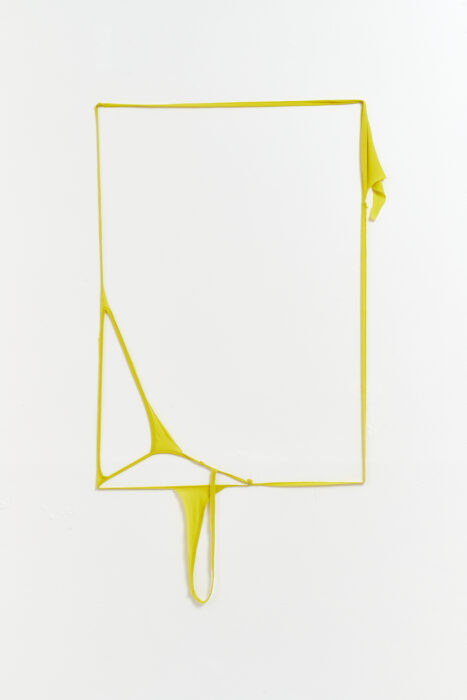The group show revolves around unstable constellations and arrangements of materials such as textile, wire, wax, Vaseline or foam. Fragile, but also poetic narratives emerge. In the fragility of the material, the potential of change is triggered associatively.
Works such as Twist by Hannah Bohnen tilt between familiar solid formats and the appearance of fragile tactility that is incompatible with them: sheets of foam soaked in plaster are brought into shape by folding, draping or knotting. In the gradual hardening of the plaster layers, a transfer of the soft material to a durable sculptural structure takes place, which remains only superficial.
Given forms of found objects and often textile everyday materials Anna Grath edit according to her sculptural ideas: they are bent, stretched, opened with incisions and connected to newly combined structures. Using a sculptural collage technique, she dissolves the functions and meanings of the things in a in a newly adjusted order.
Daniel Hörner‘s paintings question the aesthetics of deliberately used fragile materials such as wax and Vaseline in the painting process. His formally minimalist, often linear painting has its anchor in reality, in the urban environment that is present every day. The apparent approach of a cool, rational geometry, however, is opened up by emotionally dependent factors in the painting process of successively applying and removing layers of paint – and by the material affirmative presence of color.


The group show revolves around unstable constellations and arrangements of materials such as textile, wire, wax, Vaseline or foam. Fragile, but also poetic narratives emerge. In the fragility of the material, the potential of change is triggered associatively.
Works such as Twist by Hannah Bohnen tilt between familiar solid formats and the appearance of fragile tactility that is incompatible with them: sheets of foam soaked in plaster are brought into shape by folding, draping or knotting. In the gradual hardening of the plaster layers, a transfer of the soft material to a durable sculptural structure takes place, which remains only superficial.
Given forms of found objects and often textile everyday materials Anna Grath edit according to her sculptural ideas: they are bent, stretched, opened with incisions and connected to newly combined structures. Using a sculptural collage technique, she dissolves the functions and meanings of the things in a in a newly adjusted order.
Daniel Hörner‘s paintings question the aesthetics of deliberately used fragile materials such as wax and Vaseline in the painting process. His formally minimalist, often linear painting has its anchor in reality, in the urban environment that is present every day. The apparent approach of a cool, rational geometry, however, is opened up by emotionally dependent factors in the painting process of successively applying and removing layers of paint – and by the material affirmative presence of color.